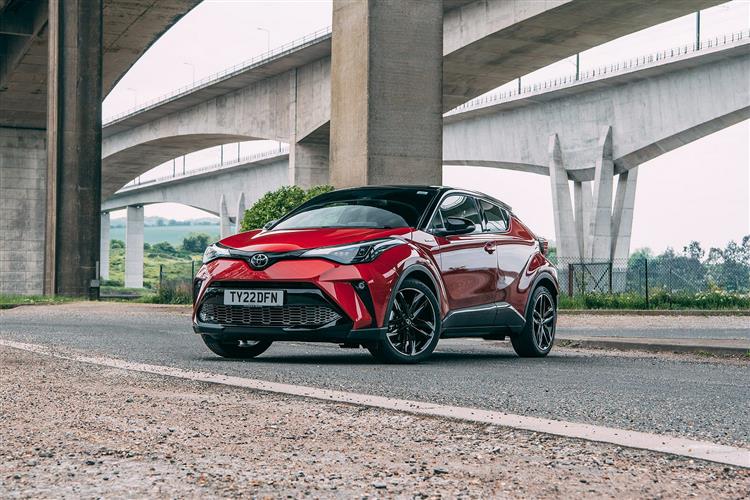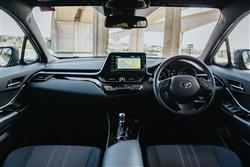A PASSION FOR FASHION (some text hidden) --NONE--
By Jonathan Crouch
Introductionword count: 65
Crossovers are ever-more crucial for the mainstream makers and this one, the C-HR, proved to be particularly important for Toyota, hence the package of improvements made in late 2019 to this lightly facelifted version. You might think it looks a little extreme. But then, it's supposed to be, aimed at Qashqai-class buyers who want to make something of a statement. This car certainly does that.
Modelsword count: 11
5 door SUV (1.2, 1.8 Hybrid - petrol) [Icon, Excel, Dynamic]
Historyword count: 470
What comes to mind when you think of a Toyota? We're guessing that it probably isn't anything like this C-HR crossover. It takes your pre-conceptions about the brand - and then stamps all over them. Back in 1994, another similarly-sized and targeted Toyota also did exactly that, the original RAV4 as dramatic a departure for the brand in its time as this C-HR - or 'Coupe-High Rider' - model was for the brand at the end of the 21st century's second decade. After the original RAV4, the innovation didn't last and subsequent RAV4s became boring and middle-aged at a time when that model line could have become the kind of fashionable 'Qashqai-class' Crossover that buyers would have loved. It could have become, well, something exactly like the C-HR. In the years immediately following its launch in late 2016, the C-HR became something of a success story for Toyota, finding over 400,000 buyers across Europe, 50,000 of those in Britain. By 2019, it was in fact accounting for nearly 40% of the UK's entire 'alternatively fuelled' vehicle market - basically the segment covering full-hybrids, Plug-ins and full-EVs. As both a crossover and a full-Hybrid, this car fitted in precisely with two growing trends - the move from conventional superminis and family hatches to compact SUVs; and the growing sense amongst consumers that they should be buying a car featuring some level of engine electrification. Plus buyers liked the trendy looks and the surprisingly sharp handling. But the competition quickly caught up. In 2019, the launch of Hyundai's Kona Hybrid delivered the C-HR its first really direct segment competitor - and that Korean model could significantly undercut this Toyota on price. Plus other trendy SUV 'B'-segment models also sprung up offering other, different routes towards powertrain electrification - mild hybrid tech for the Ford Puma, a Plug-in powertrain for the Renault Captur and a full-EV battery pack for Peugeot's e-2008. Hence the need for the package of C-HR updates that Toyota announced for this car at the end of 2019. The key change here lay beneath the bonnet. Since eight out of every ten drivers of this model wanted a hybrid, the conventional 1.2-litre petrol unit previously offered was dropped and the petrol/electric part of the range broadened with the addition of the more powerful 2.0-litre full-Hybrid engine, to sell alongside the existing 1.8-litre Hybrid powerplant. This quicker version got some suspension enhancements and across the range, there were also a few light updates to the exterior styling and the cabin, plus refinement was further improved and 'Apple CarPlay'/'Android Auto' smartphone-mirroring was added to the centre screen. It was just enough to keep this Toyota current and justify a pretty premium price tag by SUV 'B'-segment standards. The car sold in this form until the second generation C-HR arrived in late 2023.
What You Getword count: 527
Just look at it. Can this really be a model made by Toyota, a brand once so notable for forgettably-styled family hatchbacks? These days, this is a car we're now a little bit more familiar with, but see a C-HR for the first time and it's difficult to know what to look at first, with prominently projecting wheel arches, hidden rear door handles and a floating roof headlining the design flourishes. If you accept that the finished product is part-coupe, part-hatchback and part-Crossover, then without doubt it's the SUV element that's most obvious at the front, the high bonnet framing a slender upper grille and headlights smeared at each corner. Not much changed as part of the 2020 model year update in profile; not much needed to. From this perspective, the coupe cues become more obvious, with an evident sense of movement, even at a standstill, thanks to an dramatic upward centre crease that rises sharply into the power-packed rear haunches. A few subtle facelift changes feature at the rear. The ribbed rear light clusters gained super-bright LED tech, a more expressive illumination signature and progressive 'scrolling' indicators. They continued to stand proud of the tapering bodywork but in this updated form became connected by the sleek, glossy spoiler. And behind the wheel? Well it would be such a disappointment if all that exterior innovation was matched with dull, derivative interior design. Thankfully, that's not the case. The quality of this improved model's cabin was much improved - in a variety of ways. The inlays gained a more refined finish, the door panels became soft-touch in all contact areas and there was a charismatic diamond theme added to the door trim pattern, the headliner and even the needles of the analogue instrument dials. As before, the supportive sports seats position you ideally in front of an elegantly simple leather-stitched steering wheel, through which you view two deeply-cowled dials. There's a speedo and Toyota's usual hybrid 'Power' meter, these two gauges separated by a 4.2-inch colour screen for the on-board computer. Anything that small central instrument binnacle display can't tell you will probably be dealt with by the prominent eight-inch 'Toyota Touch 2' media screen. It was usefully enhanced as part of the facelift updates, first by a set of buttons and dials in the surrounding frame that make its functions easier to access on the move. And second, by the addition of 'Apple CarPlay' and 'Android Auto' smartphone-mirroring. And in the rear? Well that's where you fear that the whole C-HR experience might start to unravel. Well it is what it is. Ultimately, given the limitations of the stylised shape, we reckon the designers did pretty well here, though it's true that the cabin space in the back is generally more akin to that you'd get in Crossover with smaller outward dimensions. As for the boot, well here again, the swept-back rear styling might lead you to worry when it comes to issues of sense and sensibility. Lift the tailgate (there's no powered option) and there's quite a high loading lip, but once you get beyond it, there's a reasonably-shaped if rather shallow space, 377-litres in size.
To see the full road test text contact us on 0330 0020 227
Pictures (high res disabled)

.jpg)
|
.jpg)
|
.jpg)
| |||
.jpg)
|
.jpg)
|
.jpg)
| |||
.jpg)
|
.jpg)
|
.jpg)
| |||

|
Scoring (subset of scores)
Category: Crossover or SUV 4x4s
| Performance | |
| Handling | |
| Comfort | |
| Space | |
| Styling, Build, Value, Equipment, Depreciation, Handling, Insurance and Total scores are available with our full data feed. | |



